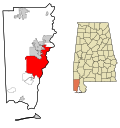Ross Knox House | |
 | |
| Location | 102 Hillwood Road Mobile, Alabama |
|---|---|
| Coordinates | 30°41′17″N88°9′0″W / 30.68806°N 88.15000°W |
| Area | less than one acre |
| Built | 1929 |
| Architect | Roberts, John Platt |
| Architectural style | Tudor Revival |
| NRHP reference No. | 08001252 [1] |
| Added to NRHP | December 30, 2008 |
The Ross Knox House is a historic Tudor Revival style residence in Mobile, Alabama, United States. The two-story brick and stucco house was completed in 1929. [1] It is considered one of the best Tudor Revival houses in Mobile by the Alabama Historical Commission. Built in the 1920s upper-class suburb of County Club Estates, it was designed by architect John Platt Roberts. [2]



